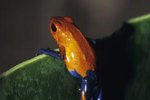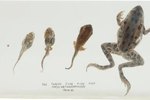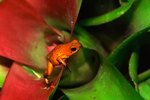
Frogs feel slimy because their skin is covered in a layer of mucus. This mucus helps the skin retain moisture, which the frog needs to breathe and stay hydrated. However, not all frogs are slimy. Depending on their habitat, frogs have different methods for keeping their skin soft and supple.
Why Frogs Need Mucus
Mucus is what makes a frog feel slippery or slimy. Frogs don't drink water, instead they absorb it through their skin. Frogs also use their skin to breathe. A layer of mucus on the skin helps keep moisture trapped next to it, and this moisture transfers oxygen into the frog's body. In this way the mucus on a frog's skin is extremely important to its well-being. Almost all frogs develop lungs when they develop into adults, but they still depend on cutaneous gas exchange (breathing through the skin) to get oxygen, especially when the frog is in a burrow underground or swimming in the water.
Where the Mucus Comes From
Mucus is excreted onto the skin via glands in the dermis. Because their skin is such an important means of respiration and hydration, amphibians tend to have more glands in their skin than other vertebrates. The most important glands are the granular and mucus glands. The granular glands secrete protein-based compounds. In poisonous frogs, the poison is produced in the granular glands. Mucus glands are much more numerous in amphibian skin than the granular glands, and are dispersed throughout the dermis. Some frogs have special lipid glands that produce a waxy substance the frog spreads over its skin. This waxy layer further prevents moisture loss. Four frogs in the genus Phyllomedusa have these special glands: P. sauvagii, P. iherengii, P. hypochondrialis, and P. boliviana. They are hylid frogs from semiarid regions of southern South America.
Mucus for Temperature Regulation
Mucus helps frogs regulate their body temperature as well as moisture and gas exchange. In basking frogs the mucus secretion is linked to body temperature -- the warmer the frog gets, the more mucus it secretes. Some frogs build up layers of dried mucus on the skin to retain further moisture, especially in hot environments. Frogs in the genus Hyperolius are known for building such layers of mucus.
Frog Cocoons
Frogs shed their outer layer of skin frequently, sometimes as often as every day. During shedding the frog loosens the skin by wriggling about, then pulls the shed layer off over its head. However, a frog may not always remove the extra skin layer. Species in certain habitats will build several layers of mucus and shed skin to form a protective cocoon that retains body heat and moisture. Cocooning is done only when the frog must hibernate or aestivate. It's possible for frogs to have dozens of cocoon layers on top of their skin. Frogs in the subgenus Cyclorana and genus Neobatrachus have been found with 50 to 100 cocoon layers. Cocooned frogs can prevent moisture loss up to 10 times better than frogs with exposed skin.
Dry-Skinned Frogs
Not all frogs are slimy. Some frogs have rough, dry skin. The bumpy, rough texture gives the skin more available surface area through which water can be absorbed. Generally rough- or dry-skinned frogs live in arid or semiarid climates where water is scarce and heat is high. These terrestrial frogs don't need super-smooth skin for swimming like aquatic frogs do, so textured skin works well for them. Many arboreal frogs and terrestrial frogs, like the desert rain frog (Breviceps macrops), have this specialized skin texture.
References
Resources
Photo Credits
-
Stockbyte/Stockbyte/Getty Images
Writer Bio
Madeline Masters works as a dog walker and professional writer. In the past she has worked as a fitness columnist, fundraising copywriter and news reporter. Masters won two Pennsylvania Newspaper Association Awards in 2009. She graduated from Elizabethtown College with a Bachelor of Arts in English.




